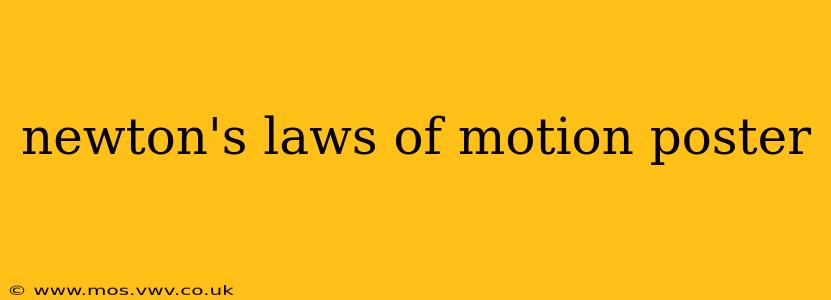Sir Isaac Newton's three laws of motion are fundamental principles in classical mechanics, laying the groundwork for understanding how objects move and interact. This poster-worthy guide provides a clear and concise explanation of each law, along with real-world examples to solidify your understanding. Let's delve into the physics that governs our everyday experiences!
Newton's First Law of Motion: The Law of Inertia
Newton's First Law states: An object at rest stays at rest and an object in motion stays in motion with the same speed and in the same direction unless acted upon by an unbalanced force.
This law introduces the concept of inertia, which is an object's resistance to changes in its state of motion. The heavier an object, the greater its inertia.
Examples:
- A hockey puck on frictionless ice: Once pushed, it will continue sliding in a straight line at a constant speed until it hits something or friction acts upon it.
- A book resting on a table: The book remains at rest because the forces acting on it (gravity and the table's upward force) are balanced.
Why is inertia important?
Inertia is crucial for understanding why seatbelts are important. In a sudden stop, your body wants to continue moving forward due to inertia, and a seatbelt prevents this potentially dangerous movement.
Newton's Second Law of Motion: Force and Acceleration
Newton's Second Law states: The acceleration of an object is directly proportional to the net force acting on the object, is in the same direction as the net force, and is inversely proportional to the mass of the object.
This law is often expressed mathematically as F = ma, where:
- F represents the net force (in Newtons)
- m represents the mass (in kilograms)
- a represents the acceleration (in meters per second squared)
Examples:
- Pushing a shopping cart: The harder you push (greater force), the faster it accelerates.
- Kicking a soccer ball: A stronger kick (greater force) results in a greater acceleration of the ball.
How does mass affect acceleration?
A heavier object (greater mass) will accelerate less than a lighter object when subjected to the same force. This is why it’s harder to accelerate a truck than a bicycle.
Newton's Third Law of Motion: Action and Reaction
Newton's Third Law states: For every action, there is an equal and opposite reaction.
This means that whenever one object exerts a force on a second object, the second object simultaneously exerts a force equal in magnitude and opposite in direction on the first object.
Examples:
- Rocket propulsion: The rocket expels hot gas downwards (action), and the gas exerts an equal and opposite force upwards on the rocket (reaction), propelling it into space.
- Walking: You push backwards on the ground (action), and the ground pushes you forwards (reaction), allowing you to move.
Are action and reaction forces always equal and opposite?
Yes, they always are. This is a fundamental principle of physics. The forces act on different objects, leading to different effects.
Frequently Asked Questions (FAQ)
What are the applications of Newton's Laws of Motion?
Newton's Laws are fundamental to countless applications, from designing bridges and buildings to understanding planetary motion and developing advanced technologies like rockets and aircraft. They form the basis of classical mechanics and are used extensively in engineering, physics, and other scientific fields.
How do Newton's laws explain projectile motion?
Projectile motion, like the trajectory of a thrown ball, is explained by combining Newton's first and second laws. Gravity provides a constant downward force (Newton's Second Law), while the ball's initial velocity dictates its horizontal motion (Newton's First Law until air resistance becomes a factor).
Are Newton's laws always accurate?
Newton's Laws are remarkably accurate for everyday situations and many scientific contexts. However, they break down at very high speeds (approaching the speed of light) and at very small scales (quantum mechanics). Einstein's theory of relativity and quantum mechanics provide more accurate descriptions under these extreme conditions.
How can I visualize Newton's Laws?
Many interactive simulations and videos online can help visualize Newton's Laws. Searching for "Newton's Laws simulation" will provide many helpful resources. Building simple experiments, like rolling balls down ramps or experimenting with colliding objects, can also provide valuable hands-on experience.
This guide provides a solid foundation for understanding Newton's Laws of Motion. By grasping these fundamental principles, you'll gain a deeper appreciation of the physics that shapes our world. Remember to explore further to uncover the nuances and complexities within these core laws!
